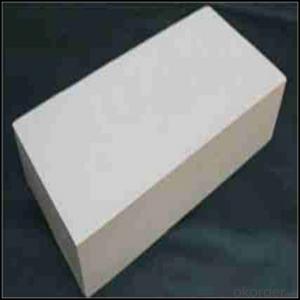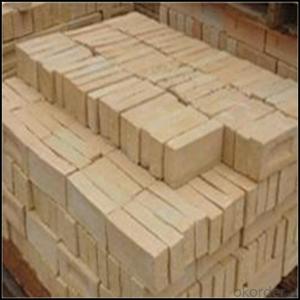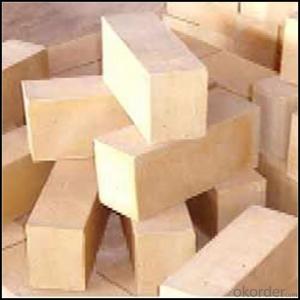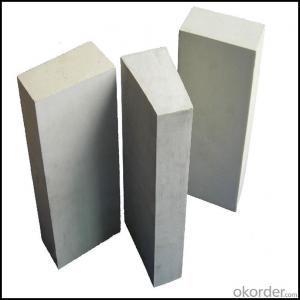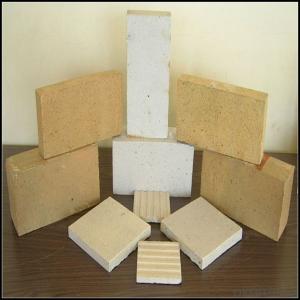Refractory Bricks for Furnace
- Loading Port:
- China main port
- Payment Terms:
- TT OR LC
- Min Order Qty:
- 0.1
- Supply Capability:
- 2000 m.t/month
OKorder Service Pledge
OKorder Financial Service
You Might Also Like
Acid Resistant Brick
CMAX firebricks are classified under temperature between 1300℃ to 1700℃, manufactured from high purity alumina clay.
High alumina refractory brick is dense shaped refractory material. With high refractoriness and mechanical behavior under high temperature, refractory brick is the necessary material of high-temperature services, mainly used for industrial furnaces and kilns and thermal equipment.
High alumina refractory brick has wide applications, mainly used in metallurgy, construction(cement and glass), petroleum, chemical industry, electric power and machine building.
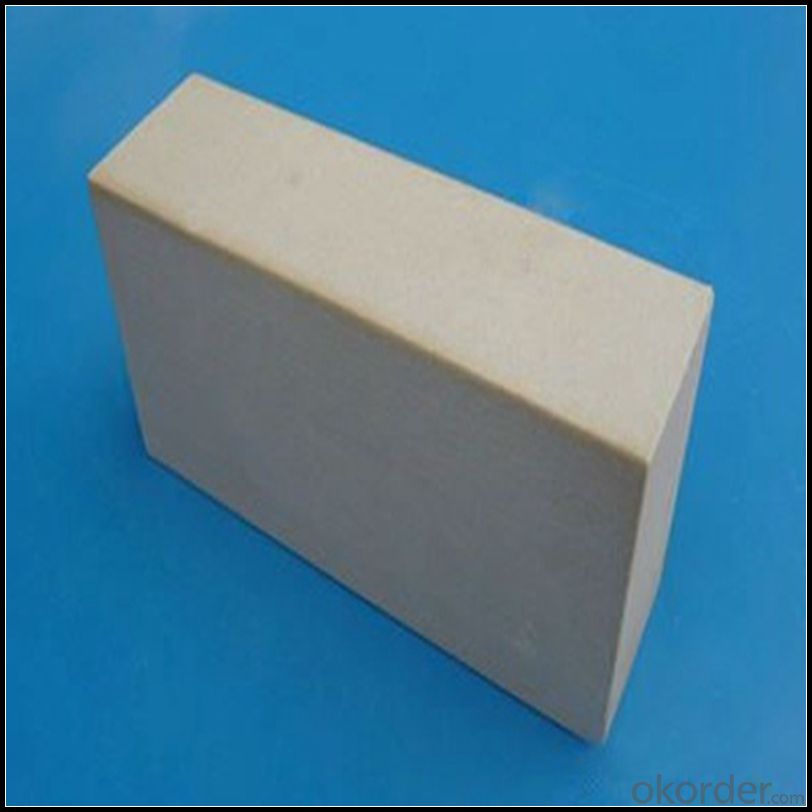
Features
Certificate of Quality for each parcel
Raw material from China, Australia and Germany
Good price
Many sizes in stock ; Making tiles accroding to your drawings
Resistance: Excellent
Quick delivery& Professional service
Excellent thermal stability
High refractoriness under load
Excellent thermal shock resistance
High refractoriness
High strength
Low thermal conductivity
Slag resistance to acid and alkaline slag erosion
Application
Light Weight Mullite Insulation Brick can be widely used for lining or insulation layers of various industrial furnaces and kilns in metallurgical industry, machine building industry, ceramic industry, chemical industry.
Data Sheet
Classification Temperature (℉/℃) | 3000/1650 |
Bulk Density (g/cm3 ) | ≤1.0 |
Thermal Conductivity | |
800℃, W/m.K | ≤0.39 |
1000℃, W/m.K | ≤0.43 |
1200℃, W/m.K | ≤0.48 |
Reheating Linear Change (%) | 1550℃×12h |
≤0.9 | |
Chemical Composition (%) | |
Al2O3 | ≥75 |
Fe2O3 | ≤0.5 |
Packaging & Shipping
Packaging Details:Be packed in fumigated wooden pallets
Delivery Detail: 30 days after order

Our Services
Optimum solution and product supply of refractories for high temperature industries, such as iron steel, non-ferrous, petrochemical and building materials.
Engineering design, contract and consult for refractories, and civil architecture design.
Research, development, manufacture and sale of superhard materials.
R&D, manufacture and sale of special packing materials for export.
Inspection, supervision and arbitration of refractories.
Consultation and services in refractories information.
Training and cultivation of high-level talents in refractories profession
Sales Network

Company Information
CNBM (China National Building Material) Group is the largest comprehensive building materials group in China that in integrate scientific research, manufacturing and logistics into one entity. The largest building materials and equipment specialists in China. Upon State Council approval, today CNBM owned more than 300 subordinate manufacturing factories and servicing companies. There are 6 fully owned public listed companies and 11 partially owned with substantial shares public listed companies. In many of these fields, CNBM is playing the leading role in the building industry in the country.
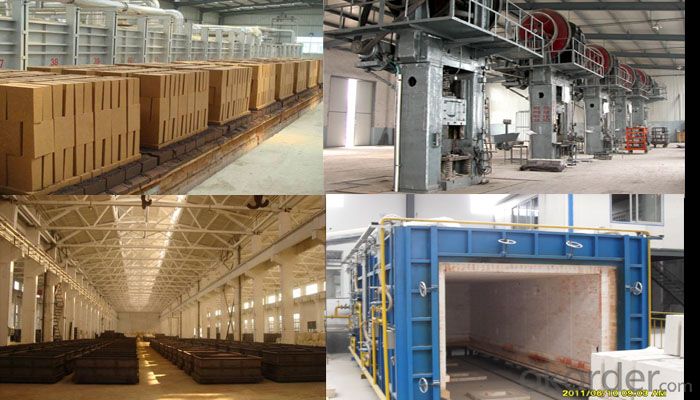
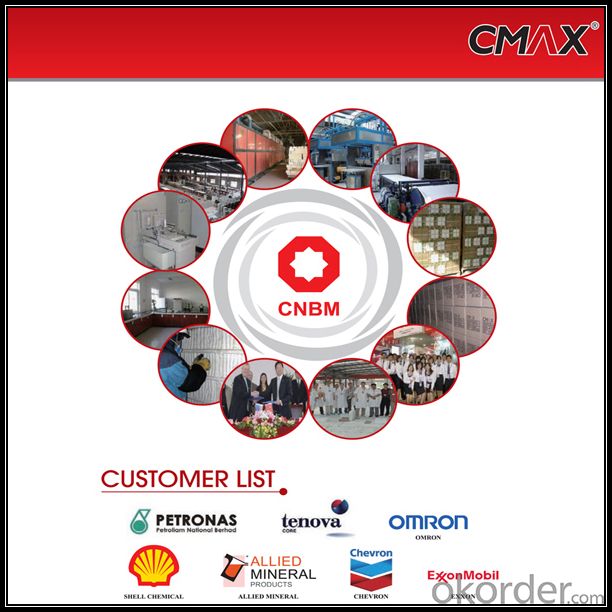
FAQ
1. Which products do you have?
We have all kinds of refractory brick, castable, mortar, cement, ceramic fiber products, etc.
Or you could browse our products to choose what you need.
2. Can you give me a brief introduction of the application of your products?
We are mainly specializing in the refractory materials in iron and steel, cement, glass, ceramics, petrochemical, electric power Industry, etc.
3. If I need your offer, what information do you need?
In order to choose suitable products, it will be appreciated to provide us the information, such us specification, technical data, order quantity, products application etc. If any question, please contact us freely.
- Q:Can insulating fire bricks be used in textile industry kilns?
- Insulating fire bricks are indeed applicable in the textile industry kilns. These bricks are specifically designed to endure extreme temperatures while providing exceptional insulation, rendering them appropriate for kiln usage. Within the textile industry, kilns are utilized for multiple procedures including fabric dyeing, drying, and curing. Implementing insulating fire bricks in these kilns guarantees the maintenance of a consistent and regulated temperature, resulting in efficient and uniform dispersion of heat. Furthermore, these fire bricks aid in minimizing heat loss, thereby leading to energy conservation and enhanced operational effectiveness. Hence, due to their thermal insulation properties and ability to endure high temperatures, insulating fire bricks are an ideal choice for textile industry kilns.
- Q:Can insulating fire bricks be used in low-temperature applications as well?
- Yes, insulating fire bricks can be used in low-temperature applications. Insulating fire bricks are designed to have high thermal insulation properties, which means they can effectively prevent heat transfer. This makes them suitable for use in both high-temperature and low-temperature environments. In low-temperature applications, insulating fire bricks can help to minimize heat loss and maintain a stable temperature. They can be used to insulate walls, floors, and roofs of structures or equipment that require temperature control, such as cold storage facilities, refrigerators, or freezers. Insulating fire bricks are also commonly used in low-temperature furnaces and kilns, where they help to minimize energy consumption and maintain a consistent temperature throughout the heating process. Their high insulating properties ensure that the heat generated inside the furnace or kiln is effectively contained, reducing heat loss and improving overall energy efficiency. Furthermore, insulating fire bricks are lightweight and easy to handle, making them convenient for various low-temperature applications. They are also resistant to thermal shock and offer excellent structural stability, ensuring long-lasting performance even in challenging environments. Overall, insulating fire bricks can be effectively utilized in low-temperature applications to enhance energy efficiency, temperature control, and structural stability.
- Q:The insulation layer destroyed after use of cement paste and tiling
- The most certain and the method can increase the area of the balcony is to eradicate the insulation layer exposed after cement wall tiles.
- Q:Is it possible to paint or coat insulating fire bricks?
- Yes, it is possible to paint or coat insulating fire bricks. However, it is important to use heat-resistant paints or coatings that can withstand high temperatures. Regular paints or coatings may not be suitable as they can crack or peel due to the intense heat. It is recommended to consult with a professional or refer to the manufacturer's guidelines to ensure the correct type of paint or coating is used for insulating fire bricks.
- Q:Can insulating fire bricks be used in the construction of ceramic tile kilns?
- Yes, insulating fire bricks can be used in the construction of ceramic tile kilns. Insulating fire bricks are specifically designed to withstand high temperatures and provide excellent insulation properties. They have low thermal conductivity, which means they help to retain heat within the kiln and prevent it from escaping, resulting in more efficient and effective firing of ceramic tiles. Additionally, their lightweight nature makes them easy to handle and install in the kiln structure. Overall, using insulating fire bricks in the construction of ceramic tile kilns can help improve energy efficiency, reduce heat loss, and ensure consistent and controlled firing temperatures.
- Q:Can insulating fire bricks be used in the construction of fireplaces?
- Yes, insulating fire bricks can be used in the construction of fireplaces. These types of bricks are designed to withstand high temperatures and provide insulation, making them ideal for lining the interior of fireplaces. They help to retain heat, improve energy efficiency, and protect the surrounding materials from excessive heat.
- Q:Can insulating fire bricks be used in power plants?
- Indeed, power plants have the capability to utilize insulating fire bricks. These bricks, also referred to as refractory bricks, are specifically designed to endure extreme temperatures and offer exceptional thermal insulation. They find extensive usage in a wide range of industrial settings, including power plants. The combustion of fossil fuels or the process of nuclear fission within power plants generates a substantial amount of heat. In order to ensure efficient operations and prevent heat loss, power plants employ insulating fire bricks to line the walls, floors, and ceilings of furnaces, boilers, and other areas that experience high temperatures. Insulating fire bricks possess a low thermal conductivity, thereby effectively reducing heat transfer. This serves to conserve energy and enhance the overall efficiency of power plants. Furthermore, these bricks exhibit high resistance to thermal shock, enabling them to withstand abrupt temperature changes without sustaining any cracks or fractures. In addition, insulating fire bricks are lightweight and simple to install, making them an ideal choice for power plant applications. They also possess resistance to chemical corrosion, which is crucial in power plants where various gases and chemicals are present. To summarize, insulating fire bricks are an appropriate option for power plants due to their ability to endure high temperatures, offer exceptional thermal insulation, and resist thermal shock and chemical corrosion. Incorporating these bricks into power plant applications serves to enhance energy efficiency and maintain optimal operating conditions.
- Q:Are insulating fire bricks resistant to phosphorus pentoxide?
- Insulating fire bricks are generally not resistant to phosphorus pentoxide. Phosphorus pentoxide is a highly reactive compound that can corrode and degrade most materials, including insulating fire bricks. It is important to consider alternative materials or protective coatings if there is a need for resistance to phosphorus pentoxide in a specific application.
- Q:Can insulating fire bricks be used in chimneys and fireplaces?
- Chimneys and fireplaces can indeed utilize insulating fire bricks. These bricks are specifically crafted to endure high temperatures and offer exceptional insulation. They are constructed from lightweight materials like ceramic fibers or refractory materials, which aid in minimizing heat transfer. Thus, they are an optimal choice for lining chimneys and fireplaces since they retain heat within the firebox and prevent its escape through the chimney. Moreover, insulating fire bricks enhance the heating system's efficiency by reducing heat loss and elevating the overall heat output. However, it is crucial to emphasize that insulating fire bricks should only be employed in appropriate sections of the chimney or fireplace, such as the firebox. Conversely, the smoke chamber or flue necessitate different types of bricks capable of withstanding the corrosive effects of flue gases.
- Q:Can insulating fire bricks be used as a lining for kiln cars?
- Indeed, insulating fire bricks exhibit remarkable thermal insulation qualities, rendering them appropriate for utilization as linings in kiln cars. These bricks are specifically engineered to withstand elevated temperatures without experiencing any fractures or disintegration, thereby establishing them as an optimal option for securing kiln cars. Furthermore, their lightweight composition facilitates convenient handling and installation, thereby diminishing the overall weight and energy consumption of the kiln. Consequently, insulating fire bricks effectively supply insulation and safeguard kiln cars, significantly enhancing their efficiency and longevity.
1. Manufacturer Overview |
|
|---|---|
| Location | |
| Year Established | |
| Annual Output Value | |
| Main Markets | |
| Company Certifications | |
2. Manufacturer Certificates |
|
|---|---|
| a) Certification Name | |
| Range | |
| Reference | |
| Validity Period | |
3. Manufacturer Capability |
|
|---|---|
| a)Trade Capacity | |
| Nearest Port | |
| Export Percentage | |
| No.of Employees in Trade Department | |
| Language Spoken: | |
| b)Factory Information | |
| Factory Size: | |
| No. of Production Lines | |
| Contract Manufacturing | |
| Product Price Range | |
Send your message to us
Refractory Bricks for Furnace
- Loading Port:
- China main port
- Payment Terms:
- TT OR LC
- Min Order Qty:
- 0.1
- Supply Capability:
- 2000 m.t/month
OKorder Service Pledge
OKorder Financial Service
Similar products
New products
Hot products
Related keywords
